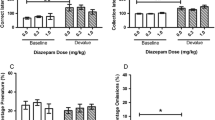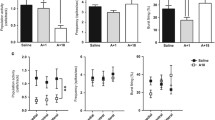Abstract
Latent inhibition (LI) of a conditioned emotional response (CER) has been proposed as a quantitative measure of selective attention. We have assessed the parallels of the pharmacology of LI in rats with the clinical pharmacology of schizophrenia. Drug and vehicle treated rats were divided into groups and preexposed 20 times to cage illumination as a CS, or not preexposed. All groups were conditioned with 2 CS-footshock pairings. The following day CER, as measured by interruption of drinking in response to CS presentation, was recorded. LI was observed as a decreased CER in preexposed relative to non-preexposed animals. LI was enhanced by haloperidol 0.3 mg/kg after 7 or 14 daily treatments, but not after a single acute dose. Haloperidol doses of 0.3 and 0.03 mg/kg enhanced LI, while doses of 0.003 and 3.0 mg/kg had no effect. Haloperidol enhancement of LI was unaffected by the coadministration of the anticholinergic agent trihexyphenidyl. Enhancement of LI is exhibited by the antipsychotic drugs fluphenazine, chlorpromazine, thiothixene, thioridazine, mesoridazine, and metoclopramide but not clozapine. The non-antipsychotic drugs pentobarbital, imipramine, chlordiazepoxide, trihexyphenidyl, and promethazine failed to enhance LI. LI exhibits striking parallels to the clinical pharmacology of schizophrenia.
Similar content being viewed by others
References
Abacus Concepts (1987) StatviewII. Abacus Concepts, Berkely, CA
Abromson LY, Seligman MP (1977) Modeling psychopathology in the laboratory: history and rational. In: Moser JD, Seligman MP (eds) Psychopathology: experimental models. WH Freeman, San Francisco, p 1
Asarnow RF, MacCrimmon DJ (1978) Residual performance deficit in clinically remitted schizophrenics: a marker of schizophrenia? J Abnorm Psychol 87[6]:597–608
Asarnow RF, Steffy RA, MacCrimmon DJ (1977) An attentional assessment of foster children at risk for schizophrenia. J Abnorm Psychol 86[3]:267–275
Asin KE, Wirtshafter D, Kent EW (1980) The effects of electrolytic median raphe lesions on two measures of latent inhibition. Behav Neural Biol 28:408–417
Baldessarini RJ, Tarsy D (1980) Dopamine and the pathophysiology of dyskinesias induced by antipsychotic drugs. Annu Rev Neurosci 3:23–41
Baldessarini RJ, Cohen BM, Teichner MH (1988) Significance of neuroleptic dose and plasma level in the pharmacological treatment of psychoses. Arch Gen Psychiatry 45[1]:79–91
Baruch I, Hemsley DR, Gray JA (1988) Differential performance of acute and chronic schizophrenics in a latent inhibition task. J Nerv Ment Dis 176[10]:598–606
Beninger RJ, MacLennan AJ (1980) The use of conditioned defensive burying to test the effects of pimozide on associative learning. Pharmacol Biochem Behav 12[3]:445–448
Bernstein JG (1982) Rational use of antipsychotic drugs. In: Bernstein JG (ed) Clinical psychopharmacology, 2nd edn. John Wright-PSG, Littleton, MA, pp 145–176
Borenstein P, Bles G (1965) Effects cliniques et electro-encephalographiques du metoclopramide en psychiatrie. Therapie 20:975–995
Christison GW, Atwater GE, Dunn LA, Kilts CD (1988) Haloperidol enhancement of latent inhibition: relationship to therapeutic drug action. Biol Psychiatry 23:746–749
Danneskold-Samsoe P, Pedersen V (1976) Inhibition of conditional avoidance response by neuroleptics upon repeated administration. Psychopharmacology 51:9–14
Diaconis P, Efron B (1983) Computer intensive methods in statistics. Sci Am 248:96–108
Dunn LA, Kilts CD, Nemeroff CB (1990) Animal behavioral models for drug development in psychopharmacology. In: Moos WH, Clark JS (eds) Modern drug discovery technologies. VCH and Ellis Horwood, New York, Chichester, Brisbane, Toronto, pp 259–280
Efron B (1979) Bootstrap methods: another look at the jackknife. Ann Statist 7[1]:1–26
Efron B (1981) Nonparametric estimates of standard error: the jackknife, the bootstrap and other methods. Biometrika 68[3]:589–599
Efron B (1982) The jackknife, the bootstrap and other resampling plans. Society for Industrial and Applied Mathematics, Philadelphia
Ereshevsky L, Watanabe MD, Tran-Johnson TK (1989) Clozapine: an atypical antipsychotic agent. Clin Pharmacol 8:691–709
Feldon J, Weiner I (1991) The latent inhibition model of schizophrenic attention disorder, haloperidol and sulpiride enhance rats' ability to ignore irrelevant stimuli. Biol Psychiatry 29[7]:635–646
Freedman R, Waldo M, Bickford-Wimer P, Nagamoto H (1991) Elementary neuronal dysfunctions in schizophrenia. Schizophr Res 4[2]:233–243
Gray NS, Pickering AD, Hemsley DR, Dawling S, Gray JA (1992) Abolition of latent inhibition by a single 5 mg dose ofd-amphemine in man. Psychopharmacology 107:425–430
Grillon C, Courchesne E, Ameli R (1990) Increased distractibility in schizophrenic patients: electrophysiologic and behavioral evidence. Arch Gen Psychiatry 47[2]:171
Kane JM, Honigfeld G, Singer J, Meltzer H, and the Clozaril Collaborative Study Group (1988) Clozapine for the treatment resisistant schizophrenic: a double blind comparison with chlorpromazine. Arch Gen Psychiatry 45:789–796
Lorden JF, Rickert EJ, Berry DW (1983) Forebrain monoamines and asociative learning: I. latent inhibition and conditioned inhibition. Behav Brain Res 9:181–199
Loskutova LV, Luk'yanenko FYa, Il'yuchenok RYu (1990) Interaction of sertonin and dopaminergic systems of the brain in mechanisms of latent inhibition in rats. Neurosci Behav Physiol 20[6]:500–505
Lubow RE, Weiner I, Feldon J (1982) An animal model of attention. In: Spiegelstein MY, Levy A (eds) Behavioral models and the analysis of drug action. Elsevier, New York, pp 89–107
Mackintosh NJ (1975) A theory of attention: variations in the associability of stimuli with reinforcement. Psychol Rev 82:276–298
Marder SR, Asarnow RF, Van Putten T (1984) Information processing and neuroleptic response in acute and stabilized schizophrenic patients. Psychiatry Res 13[1]:41–49
Matthyse S (1986) Animal models is psychiatric research. In: Van Ree JM, Matthyse S (eds) Progress in brain research. Elsevier, Amsterdam pp 259–270
McEvoy JP, Butner MD, Hogarty GE (1991) Optimal dose of neuroleptic in acute schizophrenia: a controlled study of the neuroleptic threshold and higher haloperidol dose. Arch Gen Psychiatry 48[8]:739
McGhie A, Chapman J (1961) Disorders of attention and perception in early schizophrenia. Br J Med Psychol 34:103–116
Meltzer HY (1989) Clinical studies on the mechanism of action of clozapine: the dopamine-serotonin hypothesis of schizophrenia. Psychopharmacology 99:S18-S27
Meltzer HY, Matsubara S, Lee JC (1989) Classification of typical and atypical antipsychotic drugs on the basis of dopamine D-1, D-2 and serotonin2 pKi values. J Pharmacol Exp Ther 251[1]:238–246
Mendenhall W (1979) Introduction to probability and statistics, 5th edn. Duxbury Press, North Scituate, MA
Mendenhall W, Scheaffer RL, Wackerly DD (1986) Mathematical statistics with applications. Duxbury Press, Boston
Mirsky AF, Duncan CC (1986) Etiology and expression of schizophrenia: neurobiological and social factors. Annu Rev Psychol 37:291–319
Mohammed AK, Callenholm NEB, Jarbe TUC, Swedberg MDB, Danysz W, Robbins TW, Archer T (1986) Role of central noradrenaline neurons in the contextual control of latent inhibition in taste aversion learning. Behav Brain Res 21:109–118
Nestor PG, Faux SF, McCarley RW, Sands SF, Horvath TB, Petersen A (1991) Neuroleptics improve sustained attention in schizophrenics: a study using signal detection theory. Neuropsychopharmacology 4[2]:145–149
Nielsen M, Fjalland B, Pedersen V, Nymark M (1974) Pharmacology of neuroleptics upon repeated administration. Psychopharmacologia 34:95–104
Nuechterlein KH, Dawson ME (1984) Information processing and attentional functioning in the developmental course of schizophrenic disorders. Schizophr Bull 10[2]:160–203
Oltmanns TF, Ohayon J, Neale JM (1978) The effects of antipsychotic medication and diagnostic criteria on distractibility in schizophrenia. J Psychiatr Res 14:81–91
Palmstierna T, Wistedt B (1987) Staff observation aggession scale, SOAS: presentation and evaluation. Acta Psychiatr Scand 76[6]:657–663
Richelson E (1988) Schizophrenia: treatment. In: Cavenar JO (ed) Psychiatry. JB Lippincott, Basic Books, New York, 1: ch. 55
Rothman, KJ (1990) No adjustments are needed for multiple comparisons. Epidemiology 1 [1]:43–46.
Schulz SC, Butterfield L, Garciano M, Narasimhachari N, Friedel R (1984) Beyond the therapeutic window: a case representation. J Clin Psychiatry 45[5]:223–225
Segal DS, Geyer MA (1988) Animal models of psychopathology. In: Cavenar JO (ed) Psychiatry. JB Lippincott, Basic Books, New York, 3: ch. 46
Solomon PR, Crider A, Winkleman JW, Turi A, Kamer RM, Kaplan LJ (1981) Disrupted latent inhibition in the rat with chronic amphemine or haloperidol-induced supersensitivity: relationship to schizophrenic attention disorder. Biol Psychiatry 16:519–537
Solomon PR, Nichols GL, Kiernan JM, Kamer RS, Kaplan LJ (1980) Differential effects of lesions in medial and dorsal raphe of the rat: latent inhibition and septohippocampal serotonin levels. J Comp Physiol Psychiatr 94[1]:145–154
Spohn HE, Lacoursiere RB, Thompson K, Coyne L (1977) Phenothiazine effects on psychological and psychophysiological dysfunction in chronic schizophrenics. Arch Gen Psychiatry 34:633–644
Stanley M, Lautin A, Rotrosen J, Gershon S, Kleinberg D (1980) Metoclopramide: antipsychotic efficacy of a drug lacking potency in receptor models. Psychopharmacology 71:219–225
Swanepoel JWH (1986) A note on proving that the (modified) bootstrap works. Commun Statist [Theor Meth] 15[11]:3193–3203
Tsaltas E, Preston GC, Rawlins JNP, Winocur G, Gray JA (1984) Doral bundle lesions do not effect latent inhibition of conditioned suppression. Psychopharmacology 84:549–555
Van Putten T, Marder SR, Mintz J (1990) A controlled dose comparison of haloperidol in newly admitted schizophrenic patients. Arch Gen Psychiatry 47[8]:754–758
Venables PA (1966) A comparison of two flash and two click thresholds in schizophrenic and normal subjects. Q J Exp Psychol 18[4]:371–373
Weiner I, Feldon J (1987) Facilitation of latent inhibition by haloperidol in rats. Psychopharmacology 91:248–253
Weiner I, Lubow RE, Feldon J (1984) Abolition of expression but not acquisition of latent inhibition by chronic amphemine in rats. Psychopharmacology 83:194–199
Weiner I, Lubow RE, Feldon J (1988) Disruption of latent inhibition by acute administration of low dose amphemine. Pharmacol Biochem Behav 30:871–878
Willner P (1984) The validity of animal models of depression. Psychopharmacology 83:1–16
Worms P, Broekkamp CLE, Lloyd KG (1983) Behavioral effects of neuroleptics. In: Coyle JT, Enna SJ (eds) Neuroleptics: neurochemical, behavioral, and clinical perspectives. Raven Press, New York, pp 93–117
Author information
Authors and Affiliations
Rights and permissions
About this article
Cite this article
Dunn, L.A., Atwater, G.E. & Kilts, C.D. Effects of antipsychotic drugs on latent inhibition: sensitivity and specificity of an animal behavioral model of clinical drug action. Psychopharmacology 112, 315–323 (1993). https://doi.org/10.1007/BF02244927
Received:
Revised:
Issue Date:
DOI: https://doi.org/10.1007/BF02244927




